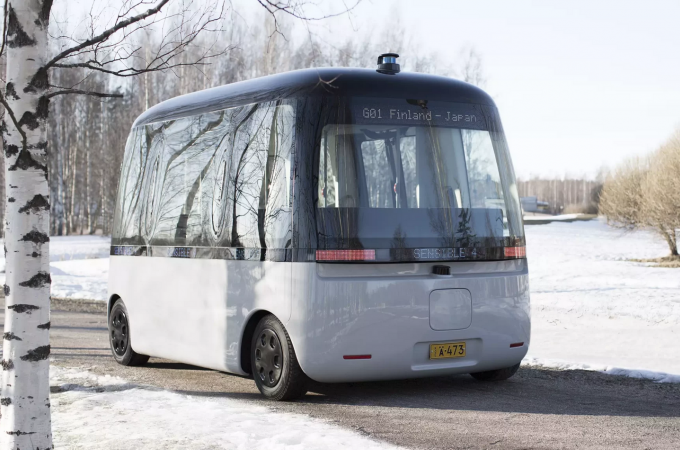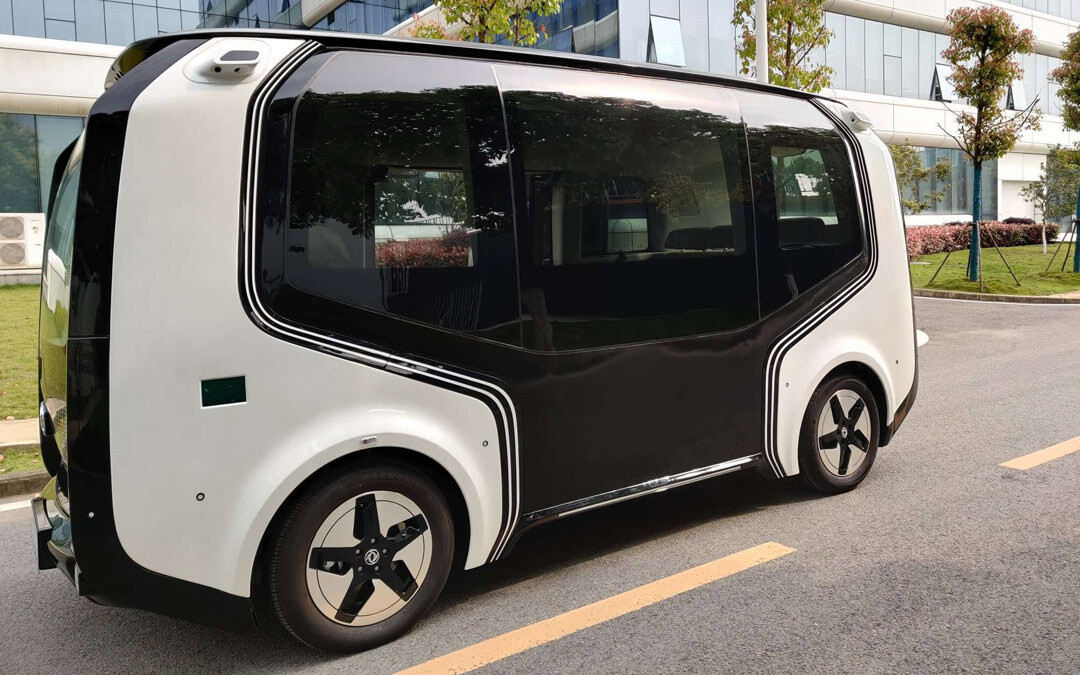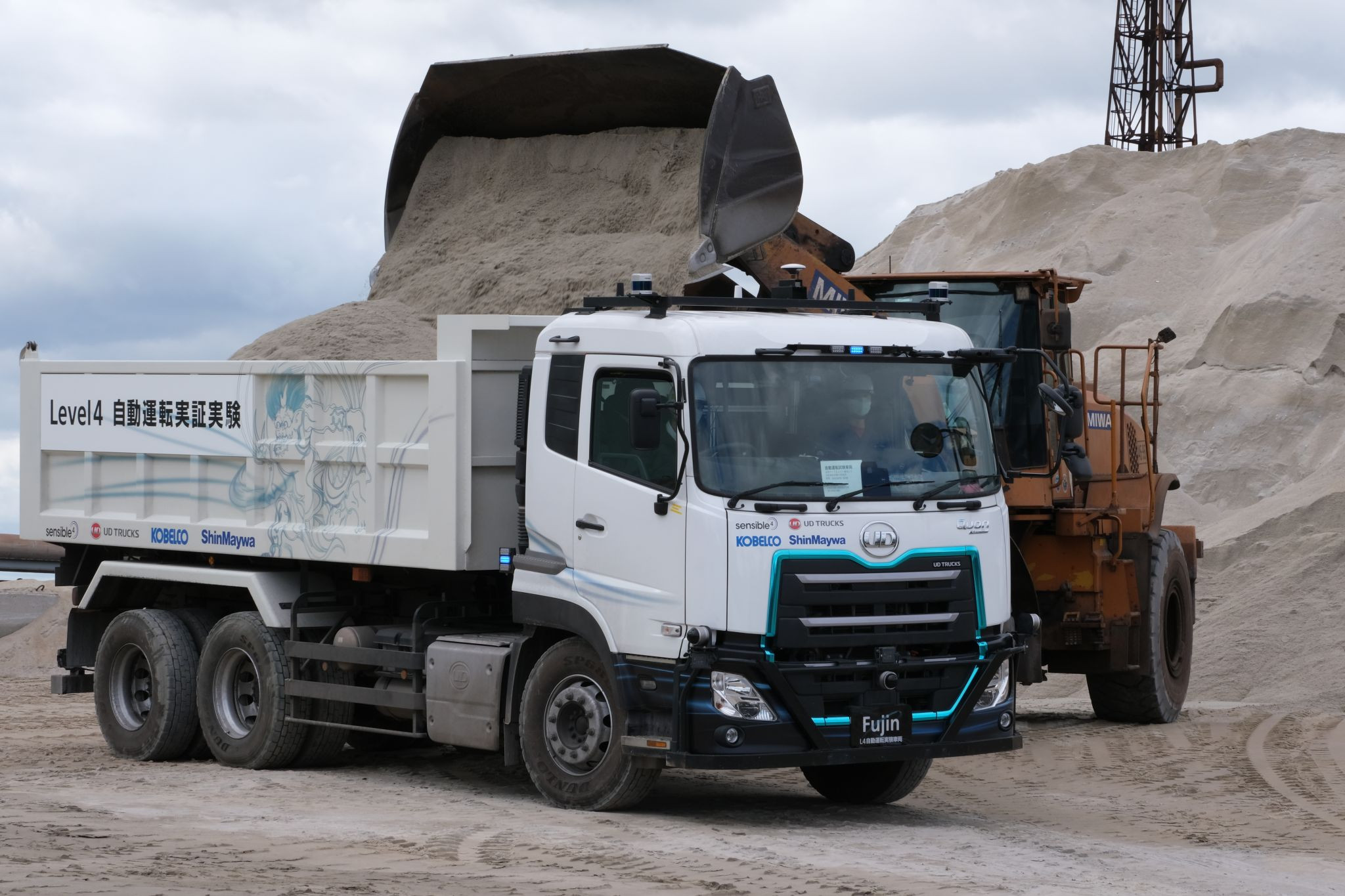Autonomy for all seasons: an interview with Finnish tech firm Sensible 4
By Bradley Osborne - 14th February 2023

'GACHA' autonomous shuttle bus by Sensible 4 and Muji
In conditions of poor visibility, human drivers often struggle to safely navigate their vehicles, and AI drivers have even greater difficulties. This month, T&BB spoke to CEO and co-founder of Sensible 4, Harri Santamala, about the company and its product, DAWN – an autonomous driving technology specifically designed to deal with all weathers and all visibility conditions.
Finland – One of the many questions which plague developers of autonomous driving technology initially appears to be very simple. How do you make a vehicle which can see the road ahead? The short answer is to give it artificial eyes: for example, cameras facing all around the vehicle; or ‘lidar’, which uses amplified light (i.e., lasers) to accurately judge distances between the vehicle and other objects. Many prototype vehicles use a combination of both. However, a vehicle cannot “see” in any meaningful sense unless it is also able to “perceive” what it can see. The act of seeing is never simply a matter of looking at something; the observer is always making distinctions between objects and interpreting them. In the driver’s situation, accurate perception is essential. Is that another vehicle or a pedestrian? What is its direction and its speed? Do I need to manoeuvre to avoid a collision? It is the job of the software embedded in autonomous driving systems to come up with answers to these questions in real time, and it can give correct ones only if it can perceive and interpret the objects surrounding the vehicle.
This job is made harder by external conditions, such as darkness, rain, snow, and floating debris, which obscure vision – a point which is as true for an AI driver as it is for a human one. An autonomous vehicle which cannot accurately perceive its surroundings, whether it be because it is too dark or because of heavy snowfall or too much dust in the air, is far more likely to overlook or misrecognise objects in its vicinity and therefore cause a serious accident.
Sensible 4’s mission, since its inception in 2017, has been to develop autonomous driving software that can work effectively in all weathers and all visibility conditions without compromising on safety. The result is ‘DAWN’, an autonomous driving platform which it launched in mid-2022. It has been tested extensively in Finland and in Japan with partners such as Toyota and UD Trucks, and it is central to an EU-funded project (‘Robust Automated Driving in Extreme Weather’) led by Halmstad University.1
Sensible 4 is one of a handful of trailblazers who have successfully brought an autonomous driving product to pilot stage, but CEO Harri Santamala emphasises the company’s careful and “sensible” approach to product development. The name ‘Sensible 4’ reflects the company’s “sensible level 4 approach to self-driving”. While others tout the possibilities of fully autonomous robotaxis, Sensible 4 chose to master “smaller domains” instead, developing vehicles that are fully automated but still require some oversight from a driver or supervisor. The number ‘4’ also signifies the four seasons of the year, and DAWN’s capability to work safely through all of them.
One “domain” which Sensible 4 has set its sights on is the industrial site. This is a setting which, in Sensible 4’s view, is ripe for automation. The trucks which operate in these sites do not have to contend with as many hazards as a vehicle travelling on public roads does, and the area in which they work is clearly bounded. “The commercial vehicles that haul material and containers, in closed industrial sites, represent a commercially viable opportunity that can be realised today”, says Santamala. Such sites include mines, refineries, wood processing plants, ports, and factories. The manoeuvres carried out by trucks in these settings are continuous and repetitive: an ideal combination for autonomous vehicles, which do not tire out and lose concentration, as human drivers do, and which are less likely to run into problems when their job is more predictable.
However, there is a catch: visibility in industrial sites is often very poor due to excessive amounts of sand, dust and mud particles in the air. These can cause serious damage to sensor equipment which is not robust enough to deal with them. Moreover, industrial sites are usually exposed to the elements, meaning harsh sunlight and pitch darkness, as well as heavy rain and snowfall. In environments such as this, where roads are simply tracks of gravel or even mud and dust, and what few road-markings there are can be easily obscured by debris or snow, conventional lane-following automation systems are of no use whatsoever. An autonomous truck which cannot work safely and effectively in challenging weather conditions is of no use to a site operator, who will need the work to be done in all weathers and even at all hours.
It is for these reasons that Sensible 4 believes it has a product with unique market potential in the commercial vehicle space.

Dongfeng shuttle bus automated by Sensible 4 and T Engineering
Background to the company
Sensible 4 was started in 2017 as a spin off from one of the first mobile robotics labs in the world, at Aalto University in Finland, but the company’s prehistory goes back as far as the 1980s. Its four co-founders – Santamala, Dr Jari Saarinen, Tommi Rimpiläinen, and Dr Jussi Suomela – have published research over the past forty years which has been cited over 2,000 times by others working in the fields of robotics, AI, and automation. Dr Suomela is a former professor at Aalto University, and the other three have worked on multiple autonomous driving projects as well as other ‘smart mobility’ enterprises. The team at Sensible 4 has gone on to win multiple awards, including Best Startup at the Dubai World Challenge for Self-Driving Cars in 2019 and a Finnish Engineering Award in 2021.
Today, Sensible 4 is a diverse workforce comprised of 89 employees with over 20 different nationalities, based at offices in Espoo, Finland and Tokyo, Japan. When asked about the company’s work culture, Santamala said:
We trust each other - everyone is able to freely decide their working hours and choose if they work from the office or remotely. With trust of course comes responsibility. Having a flat organisational structure brings the best out of us - it empowers us and ensures we collaborate closely with each other to do the very best for our partners and customers. We strongly believe that collaboration is key. It’s important for us that we’re an exciting, trusting, and attractive organisation. When looking for new talent - we’re really looking for passionate people who fit our values.
Those values, according to Santamala, are “collaboration, development, and responsibility”.
That a successful tech start-up should emerge from the city of Espoo in southern Finland is no coincidence. The current home of telecommunications giant Nokia, Espoo has a large concentration of electronics and information technology companies, supported by Aalto University and the Technical Research Centre of Finland (“VTT”). A state-sponsored initiative, ‘Enter Espoo’, calls Espoo “the city of deep tech and nature”.2 The city also benefits from its close links with the capital, Helsinki, and the city airport which is only 30 minutes away. Since 2008, an annual event called ‘Slush’ has been held in Helsinki to promote start-ups and bring them in contact with interested investors and venture capitalists.3 The population of Espoo is cosmopolitan, with foreign-born residents making up 20% of the total in 2021 (out of a population of nearly 300,000). Statistics Finland forecasts that the city will continue to grow over the next two decades.
Being in Finland means that Sensible 4 can easily recruit not only within its own borders but from the wide pool of AI and robotics engineers in the rest of the Nordics. The country offers other practical benefits, too. Santamala told T&BB that Finland’s legislation with regards to autonomous driving is “favourable”: testing of all autonomous vehicles (levels 0 – 5) is possible on public roads using a test plate certificate. Crucially for Sensible 4, southern Finland’s climate offers large variations in temperature and possibilities for extreme weather conditions throughout the year. Temperatures for nearby Helsinki range between an average low of minus 6 degrees and an average high of 22 degrees Celsius. In the summer, temperatures can reach over 30 degrees, whereas in winter they can plummet to minus 30. Winter snow can last for months, and daylight hours are very few during this season. The climate therefore offers ideal test conditions for Sensible 4’s all-weather technology; trials have been carried out on the open streets of Espoo throughout the year.
Development and testing of DAWN
Sensible 4 produced its first autonomous vehicle prototype soon after the company founding in 2017. Collaborations with East Asia quickly followed: Sensible 4’s first partnership was with Swedish firm T-Engineering, in which China’s Dongfeng Motor Corporation holds a substantial stake. The two companies worked together to automate a Dongfeng shuttle bus, which was launched in selected markets in Europe in 2022.
Sensible 4’s connections with Japan, however, have proven to be stronger over the years. They begin with ‘GACHA’, an autonomous shuttle bus which Sensible 4 claims is the world’s first such vehicle suited to all weathers. The story of GACHA begins with a chance encounter between Sensible 4 and Masaaki Kanai, the CEO of Japanese retailer Muji. Kanai was in Finland in 2017 to scout locations for his company’s European flagship store when he saw an autonomous shuttle being piloted on the streets of Helsinki. Intrigued by the strange sight and its market potential, Kanai got in touch with Sensible 4, and consequently, after 18 months of development, GACHA was premiered in March 2019. That same year, the shuttle bus won the Beazley Designs of the Year Award for Best Transport Design. GACHA has driven on the streets of Helsinki and Chiba in Japan.
In 2021, Sensible 4 successfully raised USD7m in its first major funding round (“Series A”), which was organised by Nordic Ninja and Itochu Corporation. Nordic Ninja is an initiative which channels venture capital from Japan into tech start-ups located in Scandinavia. Itochu is a diversified trading company dealing with goods such as textiles, metals/minerals, food, machinery, and information technology. In mid-2022, T&BB reported4 that an investment from Estonian firm Metaplanet Holdings had brought total investments in Sensible 4 to EUR16.7m (i.e., over USD18m); this second funding round was also led by Nordic Ninja.
Just last month, it was announced that Sensible 4 had successfully tested an autonomous truck with UD Trucks of Japan.5 The automated Quon heavy-duty truck is now engaged in regular operations, such as transporting and dumping loads, at a closed industrial site in Japan. Sensible 4 stated that the successful trial marks the beginning of a longer partnership with the Japanese company. Another partner is Toyota, who worked with Sensible 4 on an automated public transport service in the far north of Norway.
Sensible 4 has partners elsewhere in the world, including Moove GmbH of Germany. T&BB reported6 that the two companies were working on an autonomous shuttle bus back in 2021; according to Santamala, the collaboration is continuing to proceed smoothly.
‘DAWN’ – the technology which underpins every collaboration Sensible 4 has worked on – is reportedly based on “several decades” of research and development in challenging weather conditions, readily provided by the company’s home country. DAWN has been built from the ground up with the company’s proprietary software, which is tested and validated to meet automotive safety and quality standards such as ASPICE and ISOs 26262, 21448, 21434, and 22737. Santamala’s view is that extreme weather conditions, and other external factors that reduce visibility, present the “main barrier” to wider uptake of autonomous vehicles. When asked how Sensible 4 managed to overcome this barrier, Santamala listed four reasons: a smart combination of “probabilistic location algorithms”, “lidar-driven sensor fusion”, “operational design domain fit to industrial sites”, and “remote supervision where driving control remains in the vehicle”. In other words, Sensible 4’s technology takes and combines data from a range of different inputs, including (primarily) lidar, cameras, and other sensors for environmental perception; and its algorithms incorporate a degree of randomness, seeking out workable solutions to highly specific and complex problems encountered on the road. These design principles have helped Sensible 4 to meet its original remit: to produce autonomous vehicles capable of working well in fairly restricted driving scenarios and in all weathers.

Automated Quon truck by Sensible 4 and UD Trucks
The future of autonomy according to Sensible 4
Sensible 4 has a serious claim to a unique product offering – but is there a market for it?
With regards to heavy trucks, Sensible 4 sees large growth potential for its product. It believes that, in the near future, software such as DAWN will be adopted in industrial sites around the world. Santamala argues that autonomous trucks operating in these settings will be safer and more productive while also bringing down labour costs. Further, he says that operation and charging schedules for automated (electric) trucks will be easier to organise when driver shifts no longer need to be taken into consideration. The current trend, in Europe at least, is for regulation to require more and more automated driver assistance systems in commercial vehicles, and this is something which Santamala believes will work in the favour of Sensible 4.
The need for industrial sites to remain cost-competitive, in the context of rising prices for labour and raw materials, may also drive the push towards autonomous trucks. Chronic driver shortages have led to investments in process automation, but Santamala argues that solutions such as conveyor belts and special purpose vehicles (such as automated guided vehicles or AGVs) are expensive to implement. Retrofitting truck fleets with autonomous driving technology may prove to be an economical alternative. According to Santamala, many industrial sectors, such as ports, are lagging behind in automation, with only 3% of the world’s ports being partially automated. This, of course, means there is a large opening for technologies such as Sensible 4’s.
What is true for Europe and North America – driver shortages, rising costs – is equally true for Japan, and Sensible 4 sees “huge growth potential” in the Japanese market in the coming years. Moreover, Japan is not immune to difficult weather such as heavy snowfall, and so the need for autonomous technology that can handle such conditions is just as acute there as it is elsewhere. It is precisely because of such needs that Sensible 4 has a chance for wider success. The field of vehicle autonomy is dominated by cloudy concepts of smart cities and fully automated transport infrastructure which have so far generated few results. Sensible 4’s success so far has come from identifying present needs that admit of a practical and “sensible” solution.
1 See https://truckandbusbuilder.com/article/2022/11/01/eu-funded-project-will-develop-autonomous-driving-technologies-for-extreme-weather for further details on the ‘ROADVIEW’ project.
3 https://www.slush.org/events/helsinki/
5 https://truckandbusbuilder.com/article/2022/12/29/sensible-4-and-ud-trucks-test-autonomous-truck-in-industrial-site; see https://www.youtube.com/watch?v=4vUPLqmQnJQ to watch the truck in action.

Harri Santamala is one of the co-founders of Sensible 4 and is considered a “thought leader” in the space of road automation in Finland. He is an expert in autonomous vehicles, with 15 years of experience in vehicle design, e-mobility and autonomous vehicle projects. He is responsible for robot bus pilots as well as electric sports car development.


